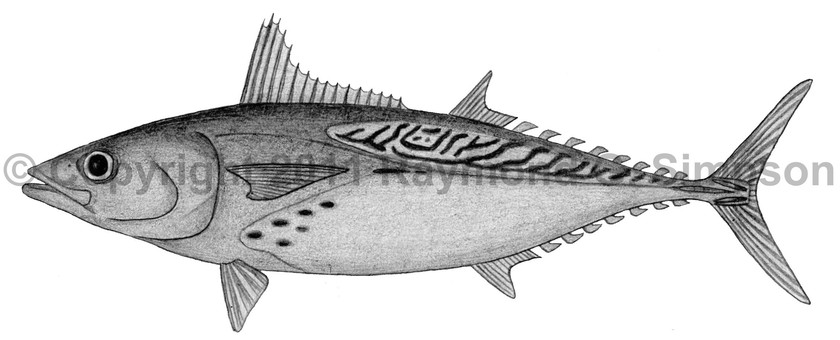
Common Name
Little Tunny
Year Described
Rafinesque, 1810
Identification
Dorsal Fin: XV-XVI, 11-13, followed by 8-10 finlets
Anal Fin: 11-15, followed by 6-8 finlets
Pectoral Fin: 25-29
Gill Rakers: 37-45 (first arch)
Vertebrae: 39
Body fusiform, elongate, and rounded in cross-section. Snout about twice eye diameter. Adipose eyelid absent. Jaw extends to anterior half of orbit. Teeth small and conical. Tongue with two strong ridges. Two interpelvic processes; shorter than pelvic fins. Dorsal fins separated by a very small gap. Spiny dorsal fin long, with a strongly concave margin. Second dorsal and anal fin small with tall anterior lobes. Pectoral fin short (not reaching end of corselet). Caudal fin semilunate. Corselet well developed; extends posteriorly to second dorsal fin origin. Body naked apart from corselet. Lateral line with a weak anterior arch. Two small caudal keels with a larger median keel in between them.
Color
Body bright silvery grading to dark blue or blue-green above. Dorsal midline almost black. A series of dark bars and lines along dorsal surface posterior to pectoral tip. There are a variable number of round dark spots under the pectoral fin. Fins dusky to blue-black except for the analfin/finlets which are pale. The first dorsal fin often has a dark tip.
Size
Maximum size to around 100cm FL. Common under 80cm FL.
Habitat
Pelagic in nearshore continental waters or around islands. Forms large schools.
Range
New England to Brazil, including the Gulf of Mexico and the Caribbean Sea. Also Bermuda.
References
Collette, B.B. 2002. Scombridae (pp 1836-1857). In: Carpenter. 2002. The living marine resources of the Western Central Atlantic. Vol. 3: Bony fishes part 2 (Opistognathidae to Molidae), sea turtles and sea mammals. FAO Species Identification Guides for Fisheries Purposes. American Society of Ichthyologists and Herpetologists Special Publication No. 5.
Froese, R. and D. Pauly. Editors. 2011.FishBase. World Wide Web electronic publication. www.fishbase.org
McEachran, J.D. and J.D. Fechhelm. 2005. Fishes of the Gulf of Mexico. Volume 2: Scorpaeniformes to Tetraodontiformes. University of Texas Press, Austin. i-viii +1-1004.